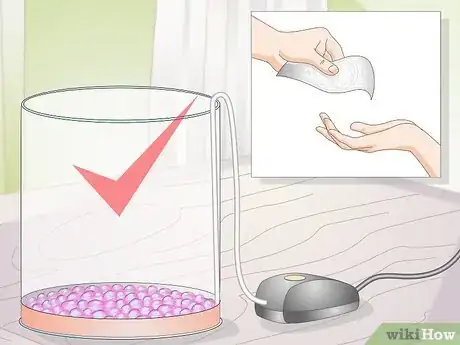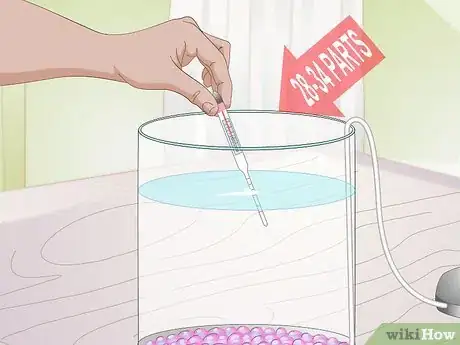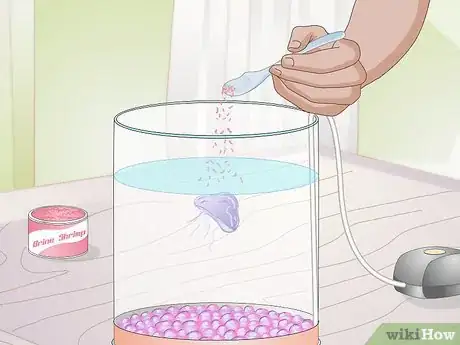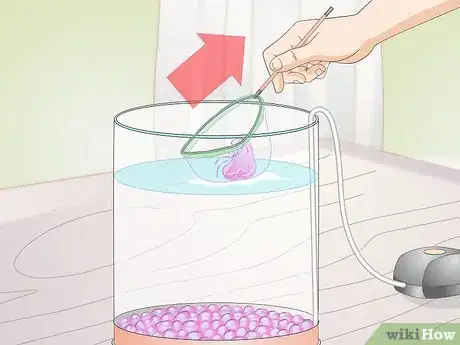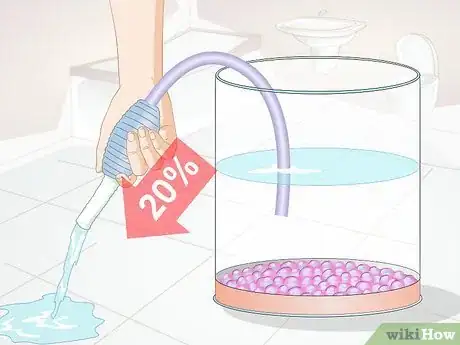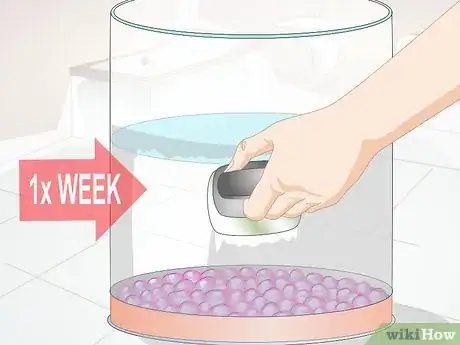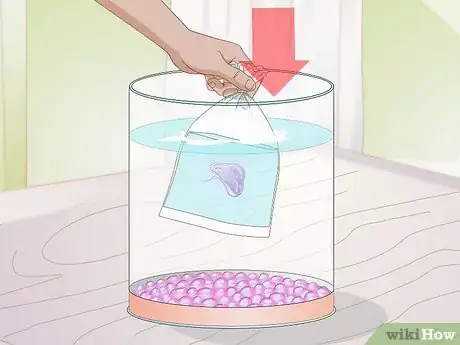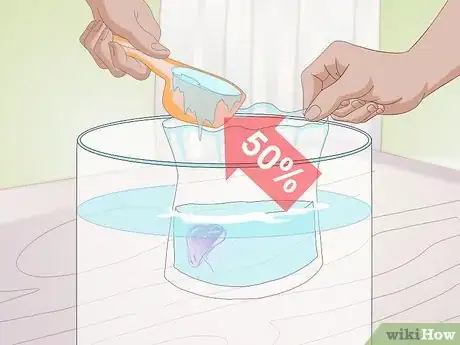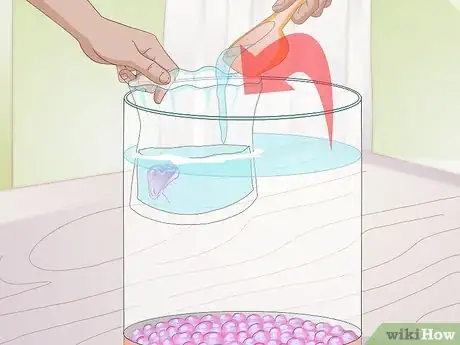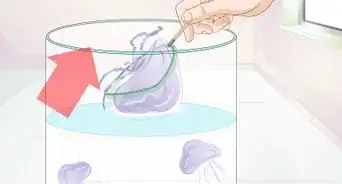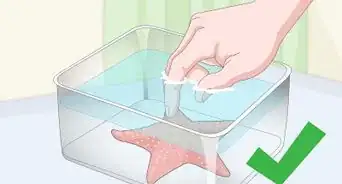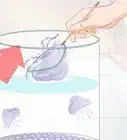This article was co-authored by Craig Morton. Craig Morton is the CEO of Aquarium Doctor Inc. based in Huntington Beach California and servicing Orange County, Los Angeles County, and the Inland Empire. With over 30 years of aquarium experience, Craig specializes in creating custom aquarium designs along with aquarium installation, service, and maintenance.
There are 7 references cited in this article, which can be found at the bottom of the page.
This article has been viewed 40,215 times.
Jellyfish can make great pets. To keep them healthy and happy, you will need to maintain their tank. Ensure their water is clean, deionized, and at an appropriate temperature and salinity. Change the water and clean the tank regularly. Give new jellyfish time to acclimate to their tank by slowly mixing the water in their bag with water in the tank.. Jellyfish are fascinating but delicate creatures, so always be gentle when moving them.
Things You Should Know
- Keep the tank water slightly above room temperature and at a salinity of 28-30 parts per thousand, add nitrifying bacteria, and feed the jellyfish twice a day.
- Scoop your jellyfish into a plastic bag filled with water and remove 20% of the tank’s water before cleaning it and adding new water.
- With a new jellyfish, place their bag in a filled tank and wait 10 minutes before slowly filling the bag halfway with tank water, and allow them to adjust.
Steps
Creating a Healthy Environment
-
1Buy a jellyfish tank. Several companies offer ready-made jellyfish and jellyfish tanks.[1] The benefit of buying a premade jellyfish tank is that all the parts and pieces you need will be easily assembled, saving you the stress of figuring out what kind of filter, pump, and tank you need for your jellyfish.
- After you get the tank assembled, the manufacturer will send you jellyfish in the mail.
- Your tank should be a Kreisel or pseudokreisel design. A standard boxy fish tank will not do. This is because jellyfish need slowly circulating water. A kreisel or pseudokreisel design accomplishes this by creating a current that runs in a circle around the top, bottom, and sides of the tank.
- You should have at least two gallons of water per jellyfish. In other words, if you have three jellyfish, your tank should be no smaller than six gallons.
- Consult a pet shop proprietor or marine life expert if you are unsure of what kind of tank you need.
-
2Ensure the right temperature. Jellyfish should be in water that is approximately room temperature, between 70-72 degrees Fahrenheit. Slightly higher temperatures (up to 75 degrees Fahrenheit) may improve the growth rate of your jellyfish. Water temperatures can dip to around 60 degrees Fahrenheit without adversely affecting your jellyfish.
- Some species of moon jellyfish can tolerate temperatures up to 80 degrees Fahrenheit.[2]
- Always consult your vet or a marine expert to ensure you keep your particular jellyfish species at an appropriate temperature.
- Put a waterproof thermometer in your jellyfish tank. Monitor the temperature regularly. If your tank is too cold, you could place a heat lamp near the outside of the tank to raise the temperature, or try simply raising the temperature of your home thermostat.
- If your jellyfish habitat is too hot, consider moving the tank to a cooler location like a basement, or invest in an aquarium cooler.[3]
Advertisement -
3Add nitrifying bacteria. Nitrifying bacteria are an important part of your jellyfish tank. In their natural environment, jellyfish would be surrounded by nitrifying bacteria (microorganisms that consume ammonia and turn it into nitrite and nitrate).
- There are many kinds of nitrifying bacteria available. Jellyfish tanks should be given nitrifying bacteria appropriate for saltwater.[4]
- Nitrifying bacteria are common in many aquarium setups, and can be purchased from your local pet store.
-
4Monitor the water’s salinity. Jellyfish should be kept in water with a salinity of at least 28-30 parts per thousand and a maximum level or around 32-34 parts per thousand. Use a hydrometer to measure the water’s salinity, and ensure that when you change the water, it is at an appropriate salinity level.
- Hydrometers are readily available at pet stores and online.
- Introduce your jellyfish to a tank with a salinity level that is slightly higher than normal. This way, they have a better chance at floating. You can gradually reduce the salinity over time. Water with a salinity level that is too low will make them sink.
- If you need to adjust the salinity, remove your jellyfish from the tank and place them in a smaller quarantine tank. Dump the main tank out and mix a new batch of water at the correct salinity. Connect your pump to ensure the water mixes well for about 24 hours. Check the water in your hydrometer. Repeat as needed.
- Do not use tap water to create saltwater for your tank. Buy deionized or reverse osmosis water from your grocery store, and add Jelly Salt (a salt specifically designed for jellyfish habitats) in an appropriate amount.
-
5Feed your jellyfish. Jellyfish should be fed twice each day. They can be fed a mix of dry, frozen, and live foods. Live rotifers, for instance, are a good jellyfish snack. Jellyfish also enjoy eating baby brine shrimp.[5] Commercially available jellyfish foods might be available at your local pet store or online.
- One half to one full scoop of commercial jellyfish food is usually enough. Check manufacturer directions for specific use directions.
- When feeding your jellyfish shrimp or other live food, add a small amount (one tablespoon’s worth) at first, then add more gradually over time. If you notice a surplus of shrimp in the tank after feeding, reduce the amount of live food you’re feeding your jellyfish. It should get only as much food as it can eat in an hour.
- Do not pour water from baby brine shrimp tanks into your jellyfish tank.
Cleaning the Tank
-
1Remove your jellyfish. Scoop your jellyfish into a plastic bag filled with tank water. Place the bag in a smaller, separate quarantine tank and pull it down and away from your jellyfish. The quarantine tank should have water of the same temperature, pH, and salinity as that of your main tank. Removing your jellyfish will allow you to change the water and clean the tank without disrupting or hurting them.
- Always be gentle with your jellyfish. Since jellyfish are 90% water, they can be hurt very easily.[6]
-
2Remove 20% of your tank’s water. Water changes are important because they remove excess nitrates -- toxic ingredients that can harm your jellyfish if they build up over time. For instance, if your tank holds ten gallons, you should remove two gallons. Use a measuring cup or siphoning hose to add and remove the water.
-
3Clean your tank once each week. After removing 20% of your water during your weekly cleaning, use an algae cleaner magnet to scrub the walls of your tank clean. You should also use this time to remove and scum or debris that might be at the bottom of the tank or floating on top. Attach a specialized aquarium cleaning cloth to a short pole (often packaged with the cleaning cloth) ti help you scrub the inside of the tank.[7] Use a filter sock and protein skimmer to remove yucky bits from the tank that you may scrape off.[8]
-
4Add new water to the tank. Add new water equal in amount to that which you removed to the tank. For instance, if you removed two gallons, add two gallons back into the tank. Ensure the water is of a ph, salinity, and temperature equal to that of the rest of the tank.
- Place your jellyfish back into their tank, using the same plastic bag method that you used to move them to the quarantine tank.
- Keep your jellyfish submerged at all times.
- Once each month, perform the same cleaning process but empty and replace 50% of the water, rather than just 20%.
-
5Keep the pH levels normal. Jellyfish require a pH level of between 8 and 8.4. Buy a hand-held pH meter and check the pH at least once a week. If your water is deionized and at the appropriate salinity, and your pumps are working properly, you shouldn’t have any trouble with pH levels.
- You should also add a chemical filtration to maintain pH levels. Chemical filtration is an additive you can use to remove phosphates and other organic compounds that can discolor your aquarium water, produce unpleasant odors, and encourage algae to grow. Activated carbon and resins are the most common types of chemical filtration media. You can obtain these at local pet stores or online.
- If you continue to have trouble with you tank’s pH levels, change the water and check your pumps. Consult a veterinarian if you continue to have problems with your jellyfish habitat’s pH levels.
Acclimating New Jellyfish
-
1Allow jellyfish to adjust. When moving jellyfish from a store-bought bag to its own tank, place the jellyfish -- still sealed in its bag -- in the water. This will allow the water in the bag to warm or cool to the temperature of the water in the tank. Do not remove the jellyfish from its bag.[9]
- Wait about ten minutes for the jellyfish to acclimate.
-
2Remove about half the water from the jellyfish bag. You could use a measuring cup or ladle to remove the water. Whatever you do, don’t dump the water out of the bag, since you’ll run the risk of dumping your jellyfish out along with it.
- If moving jellyfish from one tank to another, place it in a plastic bag of an appropriate size. The jellyfish must have room to move. A small jellyfish can be placed in a big plastic bag, and a larger jellyfish can be placed in a very large plastic bag.
-
3Fill the bag halfway with tank water. With half the water from the bag poured out, you’ll need to fill it back up with tank water. You might be able to add water to the bag by holding the top edge of the bag just above the level of the water in the tank, then dipping one corner of the bag down slightly below the level of the water, allowing water to fill it.
- Alternately, you could try filling the bag with tank water using a ladle or measuring cup.
- Keep the jellyfish sealed in its bag, and keep the bag in the water for another ten minutes.
- When the ten minutes are up, remove the jellyfish from the bag. Open it at the top and carefully pull it down the length of the jellyfish, then move it away and out of the water.
Community Q&A
-
QuestionCan jelly fish be out of water for a bit?
 Community AnswerNo. Jellyfish cannot breathe outside of water, so they will die pretty quickly if you take them out.
Community AnswerNo. Jellyfish cannot breathe outside of water, so they will die pretty quickly if you take them out.
Warnings
- Avoid using any soaps in cleaning the tanks. Most soaps and chemicals are toxic to fish.⧼thumbs_response⧽
- Clean the outside with ammonia free glass cleaner.⧼thumbs_response⧽
- If your jellies are contracting their tentacles or not moving in a regular way, remove them from the water and place them in a quarantine tank. Empty the water from the main tank and clean it thoroughly, then replace the water and jellies.⧼thumbs_response⧽
- Be careful not to get stung by the jellyfish.⧼thumbs_response⧽
Things You'll Need
- Algae scraper
- Scrubbing pad
- Large bucket
- Paper towels
- Scoop
- Siphon
- Deionized, dechlorinated water
- Aquarium thermometer
- Jellyfish salt
References
- ↑ http://www.huffingtonpost.com/entry/pet-jellyfish-tank-art_us_56732379e4b0b958f655ea29
- ↑ http://www.advancedaquarist.com/2012/8/inverts
- ↑ http://www.advancedaquarist.com/2012/8/inverts
- ↑ http://www.drtimsaquatics.com/resources/helpful-hints/one-and-only-nitrifying-bacteria-faqs
- ↑ http://www.advancedaquarist.com/2012/8/inverts
- ↑ http://www.huffingtonpost.com/entry/pet-jellyfish-tank-art_us_56732379e4b0b958f655ea29
- ↑ http://www.jellyfishfacts.net/maintaining-your-jelly-tank.html
- ↑ http://www.advancedaquarist.com/2012/8/inverts
- ↑ Craig Morton. Fish & Aquarium Specialist. Expert Interview. 21 July 2020.
About This Article
To maintain a jellyfish tank, you should clean it weekly and replace 20 percent of its water. However, once a month you should also replace 50 percent of its water to keep it clean. Before you clean tank, first scoop your jellyfish out with a plastic bag filled with tank water. Then, if it's a weekly clean, remove 20 percent of your tank’s water with a measuring cup or siphoning hose. Once you’ve removed the water, use an algae cleaner magnet to scrub the outside walls of the tank and an aquarium cleaning cloth to scrub inside. When your tank’s all clean, replace the 20 percent of water you removed with clean water. Finally, check your tank water’s pH level is between 8 and 8.4 and return your jellyfish. For more tips from our Veterinary co-author, including how to help your jellyfish get used to its tank, read on!
